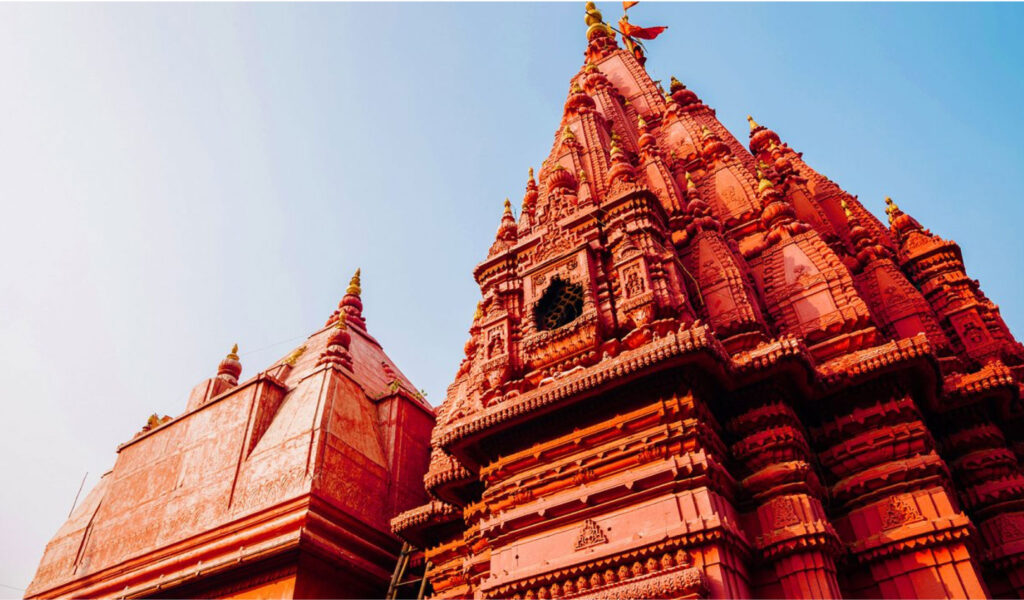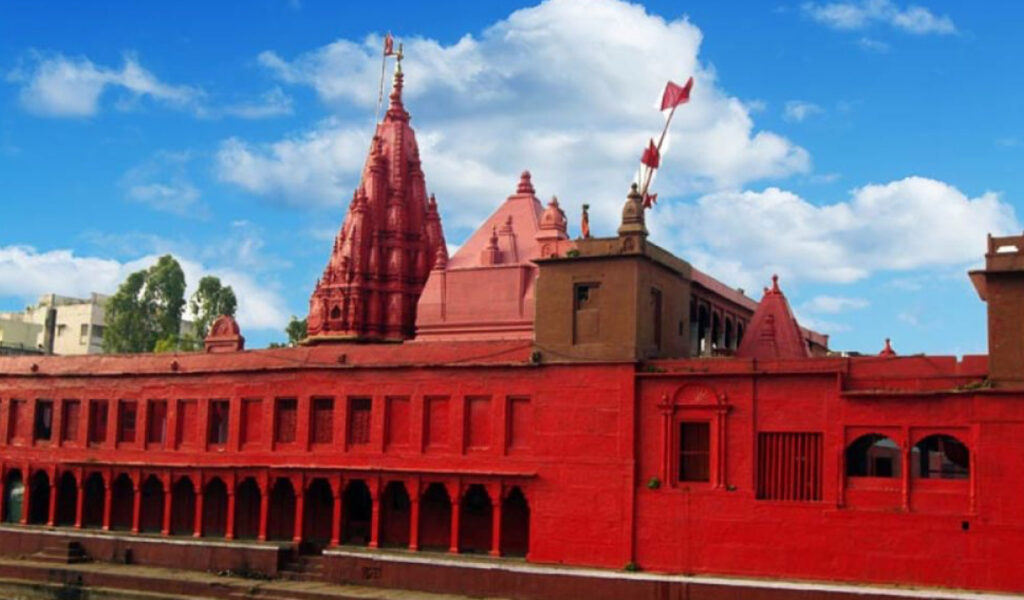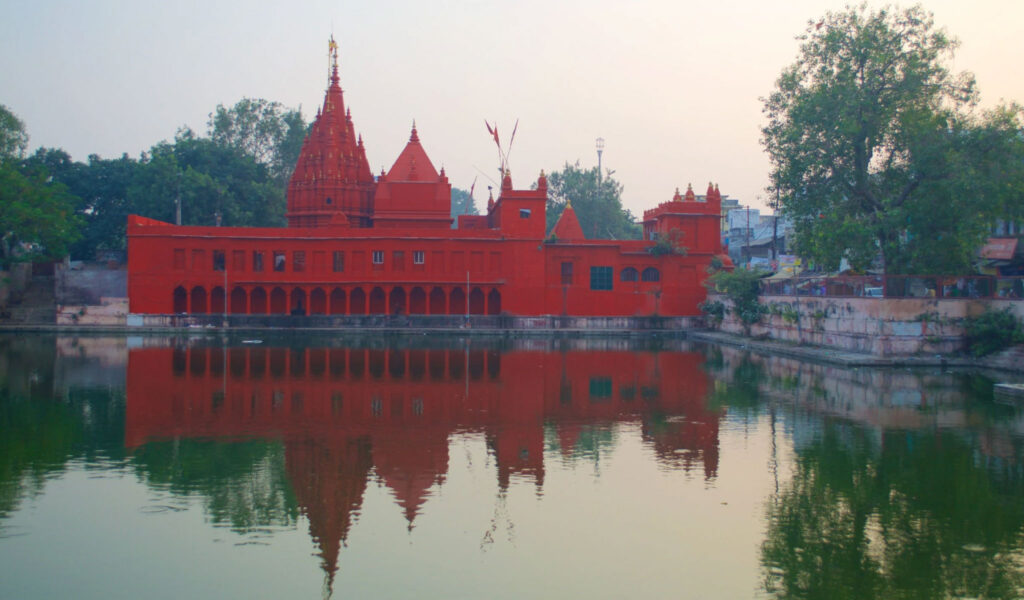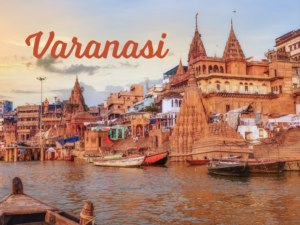Durga Temple, Varanasi – The Scarlet Shrine of Shakti

Among the many famous places in Varanasi, the Durga Temple stands out for its vibrant red façade and powerful presence. Known locally as the Durga Kund Mandir, it’s a temple of energy and grace — dedicated to Goddess Durga, the fierce yet compassionate mother goddess. Built beside a rectangular pond (kund), it radiates a spiritual magnetism that draws both pilgrims and travellers. If you’re mapping your Varanasi visit places, this temple is a must-see — not just for devotion but also for its striking architecture and mythic charm.
Where Is Durga Temple? (With GPS Coordinates)

📍 Coordinates: 25.2969° N, 82.9776° E
The Durga Temple is located near Durga Kund in the southern part of Varanasi, close to Assi Ghat and the Banaras Hindu University (BHU) campus.
It’s about 5 km from Varanasi Junction Railway Station and 2 km from Sankat Mochan Hanuman Temple — making it an easy addition to a tour guide in Varanasi circuit.
The temple area is peaceful yet lively, surrounded by flower stalls, brass-item shops, and tiny eateries serving fresh prasadam and sweets.
Mythological & Historical Significance

Legend says that Goddess Durga appeared here to protect the city from demons, and the temple was later built to honour her power. The Durga Kund Temple is believed to be a self-manifested (svayambhu) shrine — the idol of the goddess is said to have appeared by divine will, not crafted by human hands.
Historically, the temple was commissioned in the 18th century by Rani Bhabani of Natore (Bengal), a devout queen known for her temple patronage. It soon became a central Shakti Peeth in Kashi, attracting devotees during Navratri when the temple glows with thousands of lamps and the chants of “Jai Mata Di!” echo in the air.
Even today, locals believe that offering red flowers or sindoor here helps overcome obstacles — a practice passed down generations.
Architecture

Architecturally, the Durga Temple is a fine example of North Indian Nagara style. Its tall shikhara (spire) and multi-tiered smaller towers are painted in deep red ochre — symbolic of Shakti (divine feminine energy). The sanctum houses the black-stone idol of Goddess Durga adorned with flowers and silver ornaments.
Outside, the Durga Kund — a large rectangular tank — mirrors the temple’s red reflection, creating a mesmerizing sight at sunrise and dusk. Steps descend into the pond, where devotees once performed rituals.
Carvings on the walls depict forms of Devi and Hindu mythic motifs. The rhythmic sound of temple bells, the fragrance of marigolds, and the hum of mantras make this one of the most spiritually charged places of visit in Varanasi.
What You’ll See & Do at Durga Temple

As you enter the temple complex, you’re greeted by the red-painted spires and the rhythmic chanting of devotees. Inside, you can offer flowers, coconut, and sindoor to the goddess.
During Navratri (September–October), the temple becomes a sea of saffron and red — thousands gather for daily aarti, dance, and music.
The nearby Durga Kund pond is a picturesque spot for reflection, and you may see priests performing rituals by its edge.
Around the temple, explore small stalls selling religious items, brass lamps, rudraksha malas, and sweets like laddoo and boondi. Hiring a tour guide in Varanasi adds depth — they narrate local legends, temple myths, and stories of Rani Bhabani’s devotion that most visitors miss.
How to Reach Durga Temple
By Air: The nearest airport is Lal Bahadur Shastri International Airport, about 25 km away.
•By Train: Varanasi Junction (Cantt) and Kashi Railway Station connect major cities. From there, take an auto or cab (20 min).
•By Road: The temple lies on Durga Kund Road, easily reachable by rickshaw or taxi from Assi Ghat or BHU.
If you’re visiting multiple Varanasi visit places in a day, combine Durga Temple with Sankat Mochan and Tulsi Manas Temple — all located within 2 km. Hiring a local tour guide in Varanasi helps navigate narrow roads and festival-day rush smoothly.
The southern Varanasi belt around Durga Kund is full of cultural gems. Don’t miss:
•Sankat Mochan Hanuman Temple: A lively shrine where Tulsidas met Hanuman.
•Tulsi Manas Temple: Where saint Tulsidas wrote the Ramcharitmanas.
•Assi Ghat: Famous for morning yoga, Ganga Aarti, and scenic boat rides.
•BHU Campus: With Bharat Kala Bhavan Museum housing ancient art.
Together these make a compact and enriching half-day trail through the famous places in Varanasi.
Best Time to Visit & Travel Tips
Best Time: October to March — when the weather is pleasant. Navratri and Durga Puja are peak times for festivity and devotion.
Tips:
•Morning (6 AM–9 AM) or evening (5 PM–8 PM) visits are ideal.
•Dress modestly and remove footwear before entering.
•Be mindful of monkeys around the temple and kund.
•Photography is allowed outside but restricted in the sanctum.
•Carry water and cash (no digital payments for offerings).
Visiting with a tour guide in Varanasi helps you explore hidden shrines nearby and understand temple rituals better.
Suggested Itinerary
Day 1: Arrive in Varanasi → Evening Ganga Aarti at Dashashwamedh Ghat.
Day 2: Morning visit to Durga Temple & Durga Kund → Proceed to Sankat Mochan Temple & Tulsi Manas Temple → Lunch near BHU Campus → Explore Assi Ghat at sunset.
Day 3: Boat ride on Ganga → Explore Kashi Vishwanath Corridor → Shopping for Banarasi silks.
This itinerary combines the city’s divine essence and local culture — perfect for pilgrims and travellers alike.
FAQ – Durga Temple, Varanasi
Q1. What are the opening hours of the temple?
A: The temple typically opens around 05:30 AM and remains open until about 10:30 PM.
Q2. Is there an entry fee for the temple?
A: No — there is no entry fee to visit the Durga Temple.
Q3. What is the dress code or required etiquette?
A: Visitors are expected to dress modestly (cover shoulders & knees), remove footwear before entering, and follow temple norms. Photography inside may be restricted.
Q4. Are cameras and mobile phones allowed inside?
A: Photography inside the sanctum is often prohibited, and mobile phones may need to be left in lockers outside the main shrine.
Q5. How can I get to the temple from central Varanasi?
A: The temple is located near Durga Kund on Sankat Mochan Road, in Varanasi. It’s reachable by auto-rickshaw or taxi from major hubs.
Q6. Is a tour guide available at the temple?
A: Yes, local guides are available (for a fee) to take you through the temple, though you may also visit independently.
Q7. When is the best time to visit to avoid crowds?
A: Early morning (just after opening) or weekday visits tend to be less crowded. Festival days like Navratri draw large numbers.
Q8. Is the temple accessible for people with mobility issues?
A: The temple and surrounding area have some steps and uneven surfaces; while accessible to many, it may pose challenges for those with limited mobility.
Q9. What is special about the “kund” (pond) adjoining the temple?
A: The temple sits beside a sacred pond called Durga Kund, which adds a serene water-element and mirror-effect to the red temple façade.
Q10. Are non-Hindus allowed to visit?
A: Yes — visitors of all faiths are welcome to enter the temple premises and experience the architecture and devotion.
Conclusion
The Durga Temple is more than a sacred site — it’s a living pulse of Varanasi’s devotion to the divine feminine. The blend of red spires, mythic legends, and calm waters of the kund make it one of the most compelling places of visit in Varanasi.
For anyone seeking to understand the spiritual diversity of Kashi, this temple is a radiant stop — where Shakti’s presence is felt in every chant, every flower, and every heartbeat.
Recommended Tour
Related Blogs

Kashi Vishwanath Temple: The Most Famous Place of Visit in Varanasi



